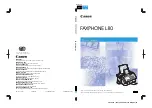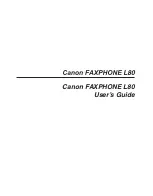
(4) Modem (R96DFXL) block
INTRODUCTION
The Rockwell R96DFXL MONOFAX modem is a synchronous 9600
bits per second (bps) half-duplex modem with error detection and
DTMF reception. It has low power consumption and requires only a
5V DC power supply. The modem is housed in a single VLSI
device package.
The modem can operate over the public switched telephone network
(PSTN) through line terminations provided by a data access arrange-
ment (DAA).
The R96SHF is designed for use in Group 3 facsimile machines. The
modem satisfies the requirements specified in CCITT recommenda-
tions V.29, V.27 ter, V.21 Channel 2 and T.4, and meets the binary
signaling requirements of T.30.
The modem can operate at 9600, 7200, 4800, 2400, or 300 bps, and
also includes the V.27 ter short training sequence option.
The modem can also perform HDLC framing according to T.30 at
9600, 7200, 4800, 2400, or 300 bps.
The modem features a programmable DTMF receiver and three pro-
grammable tone detectors which operate concurrently with the V.21
channel 2 receiver.
The voice mode allows the host computer to efficiently transmit and
receive audio signals and messages.
The modem is available in either a 100-pin plastic quad flat pack
(PQFP) or a 64-pin quad in-line package (QUIP).
General purpose input/output (GPIO) pins are available for host as-
signment in the 100-pin PQFP.
The modem’s small size, single voltage supply, and low power con-
sumption allow the design of compact system enclosures for use in
both office and home environments.
MONOFAX is a registered trademark of Rockwell International.
FEATURES
•
Group 3 facsimile transmission/reception
–
CCITT V.29, V.27 ter, T.30, V.21 Channel 2, T.4
–
HDLC Framing at all speeds
•
V.27 ter short train
•
Concurrent DTMF, FSK, and tone reception
•
Voice mode transmission/reception
•
Half-duplex (2-wire)
•
Caller ID reception (V.23 receive-1200 bps)
•
Programmable maximum transmit level:
0 dBm to –15 dBm
•
Programmable transmit analog attenuation:
0 dB to 14 dB in 2 dB steps
•
Receive dynamic range: 0 dBm to –43 dBm
•
Programmable dual tone generation
•
Programmable tone detection
•
Programmable turn-on and turn-off thresholds
•
Programmable interface memory interrupt
•
Diagnostic capability
–
Allows telephone line quality monitoring
•
Equalization
–
Automatic adaptive equalizer
–
Fixed digital compromise equalizer
•
DTE interface: two alternate ports
–
Selectable microprocessor bus (6500 or 8085)
–
CCITT V.24 (EIA-232-D compatible) interface
•
TTL and CMOS compatible
•
Low power consumption: 275 mW (typical)
•
Single Package
–
100-pin PQFP
–
64-pin QUIP
•
5VDC power supply
•
Software compatible with R96MFX, R96EFX, R96SHF, and
R96VFX modems
UX-177H
5 – 6
Summary of Contents for FO-165
Page 6: ...M E M O 1 5 UX 107U UA C UX 117U UA C FO 165U C FO 365U C ...
Page 11: ...M E M O UX 107U UA C UX 117U UA C FO 165U C FO 365U C 4 ...
Page 70: ...6 6 Control PWB parts layout Top side UX 177H ...
Page 71: ...6 7 Control PWB parts layout Bottom side UX 177H ...
Page 75: ...6 11 TEL LIU PWB parts layout Top side UX 177H ...
Page 76: ...6 12 TEL LIU PWB parts layout Bottom side UX 177H ...
Page 78: ...6 14 Power supply PWB parts layout UX 177H ...
Page 81: ...Operation panel PWB parts layout 6 17 UX 177H ...
Page 90: ...M E M O UX 177H 8 7 ...
Page 111: ...M E M O UX 177H ...
















































